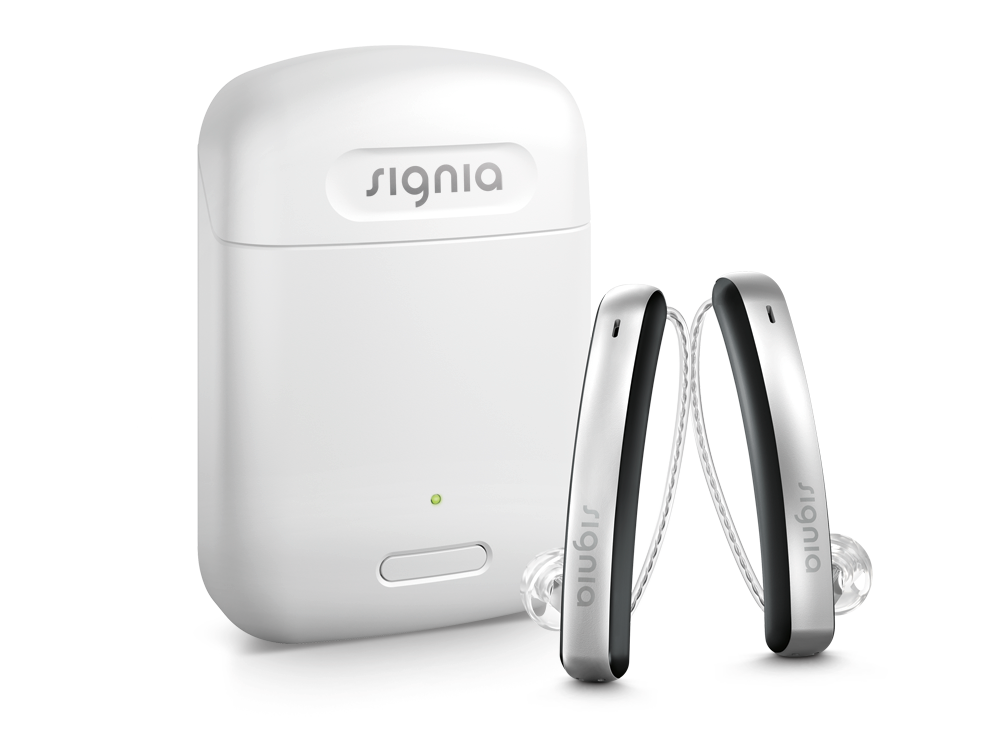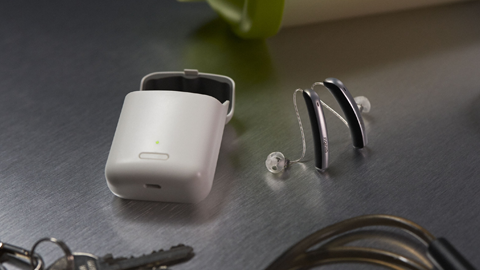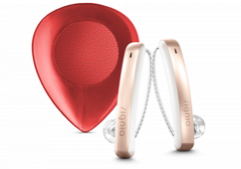Introduction
Consumer review by Mr. D. Mitchell:
Signia - Connect 7 Nx (left and right ear)
Fit by Maria Brown Hearing Clinic, Hobart TAS
Start of test 27/3/2019
End of test 13/4/2019
The team at Maria Brown Hearing Clinic asked if I'd like a sneak peek at these new Signia Connect 7 hearing aids. The manager Kevin knew I had a strong interest in sound equipment design and construction, and that I already had hearing aids. He correctly figured I would be curious about this radical new design.

First impressions
The first surprise was how long and thin they seemed, due to a new cylindrical battery format, instead of the traditional "button" batteries. The narrow, curved form makes them sit very easily behind the ear. The second surprise was the total lack of controls. No volume controls, on-off switches or buttons. Nothing!
Switch-on is done simply by removing the devices from the small storage-pod case, which doubles as the charger. It even has its own inbuilt battery for charging away from a power source. More on that later. Kevin mentioned that each aid contains not one, but two sound processing chips. This is an industry first and is a significant design refinement.
Day to day use. So, how do they stack up?
First, they absolutely excel at noise suppression. This feature is simply superb. This is programmed into the aids by the audiologist, and is something only the audiology technician can adjust, but it's so powerful, it deserves special mention. The hearing aid monitors all incoming sounds, and decides whether it is "wanted" (ie speech and music), or "unwanted" (ie noise). Its ability to suppress noises like slamming doors, is almost too good. The system relies on speech and clanking mechanical type noises being entirely different. It is able to pick out just the noise, which is a "spike" type soundwave, and treat it differently to music or speech, which are "wavy looking" waveforms, and basically chop out the noise. It works on loud noises, like dropped objects, but almost eerily, also on faint noises. The sharp, but not-so-loud "impact" noises made by say, turning on a light switch, or a computer keyboard, are so well suppressed that they sound like they are coming from the next room! This sounded weird at first, but after a couple of weeks, it was becoming second nature. It's great to have all the clanky noises of the new millenium shoved into the background where they belong, but speech and "wanted" sounds still coming through unaffected.
For people with noise induced hearing damage,who are intolerant of even slightly loud sounds, this degree of noise control is a whole new ball-game. Old fashioned aids (and also newer, cheap ones) without effective noise limiting can literally "blow your ears off". This is the main reason why these unsophisticated devices stay in bedroom drawers all over the world, instead of being worn.

Charging
Being rechargeable, there is no need to buy batteries, but crucially, you will need the storage case, which actually has a built-in battery able to store several full charges, ie several days' worth. The colour of the LED tells you whether you're good for a full charge or not, using a traffic-light system. The case itself needs topping up about twice a week with the supplied USB cable and charger. It's probably easier to just get in the habit of plugging in the case each night. For the technically minded, the charge cable is a mini USB-C to USB-A adaptor. Lots of households will have one lying around, as the same adaptor cable works on a Kindle. Hearing aid battery life was a good 18 hours plus. Despite some long days, I didn't run them flat. Charging is rapid; 15 minutes in the case gives a 60% charge. This would be useful, say, on long overseas flights. A full charge takes 4 hours.
As long as you have the charge cable and the storage pod, you're good to charge. USB-A power sockets are everywhere these days; in cars, airports, aircraft, the sides of computers, portable 'battery banks', on numerous wallplug chargers for different gadgets and even built into newer mains power outlets.
The storage case is super important - it is a vital part of the whole system, so it's essential that you can always get to it each day. It is the only, repeat, only way you can recharge the aids from its built-in reserve battery. With the aids inside the case, it is also the only way to turn them off using the single, multifunction button, although frankly that's pointless for normal use. That said, the case is only matchbox size, and will fit easily in a pocket, purse or handbag. The case is well made but it's not waterproof, so don't leave it anywhere potentially damp.
Directional functionality
Another feature, almost as good, is "Configurator", worked from the smartphone, which can concentrate sound from a particular direction. The Configurator control screen looks like a pizza. With a flick of the finger, you can select a "wedge" of direction preference for front, back, left, right, and make the selection wide or narrow. In noisy places like restaurants, it can help reduce nearby chatter and things like kitchen noise. It's quite useful for listening to TV, and reducing nearby noise if needed.
The default setting is "Auto", where the computers in the hearing aid select where the dominant speech (not noise) is coming from, and concentrate on that. A word of warning; remember to set it back to "Auto" at the end of the TV viewing or dinner party, or you might go back to missing things! A night in the recharge pod will reset everything back to auto, however.
Phone and music
As the phone is paired to the hearing aids with Bluetooth, normal smartphone functions will come though the hearing aid, so you can take phone calls hands free (once the call has been answered). A word of warning if you'll be doing this while driving. Test first, before setting out!! If your car has handsfree bluetooth pairing, it should work. Mine refused to at first, but after some fiddling, Kevin and I got it able to answer calls using the normal car controls, but neither of us could figure out what we'd done to get it going! However, sometimes it would display the caller, other times not. Others have been luckier, and have been able to literally plug and go. If you don't have handsfree, and want to take calls while driving, you'll need a phone that will auto answer. Check whether your phone can do this.
If this all sounds a problem, it's only because I haven't spared any details. But, the whole point of using a reputable hearing clinic is to have an expert adjust everything so all these potential niggles just go away.
You can stream music recorded on a phone with excellent fidelity, although as you would expect with such miniature in-ear "speakers", there isn't much bass. Live music did have a strange quirk - long continuous notes had a faint "flutter" or warble effect (tremolo, actually), which was a bit disconcerting. That was not present at all when streaming music from the phone through the earpieces.

Whistling, what whistling?
Feedback ("whistling") is a perennial bane of older hearing aid designs. I am happy to report that Signia have this sorted. I deliberately tried to provoke it many times by cupping a hand over each ear in turn. Only once did I get a brief "chirp" on one side. The rest of the time, there was not so much as a squeak. I'd rate that a huge win.
Wind noise is always a problem with exposed microphones. It is a credit to the designers that they seem to have licked this difficult problem, too. Wind noise appeared to be extremely brief and was not an issue.
Summary. What was good, what was bad?
The Good
The not so good
More information?
Click here to download a free information brochure on the new Styletto Connect.
